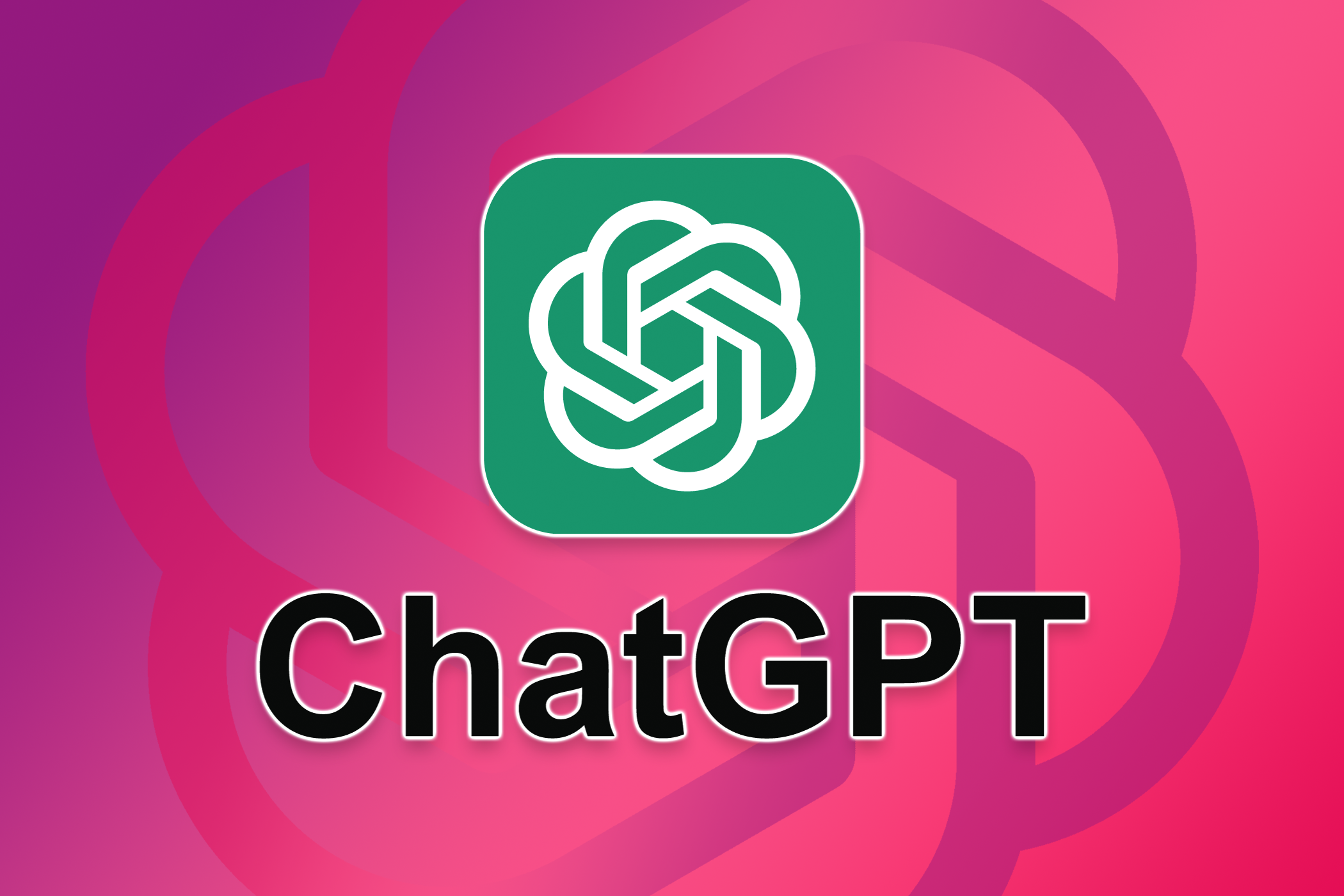
Effective Strategies for Using ChatGPT to Generate Professional Resumes Tailored for Various Positions

Effective Strategies for Using ChatGPT to Generate Professional Resumes Tailored for Various Positions
Key Takeaways
- Use ChatGPT to analyze job descriptions and identify key skills and requirements.
- Let ChatGPT create an initial draft of your resume and edit it to add personal details and make it more refined.
- ChatGPT can help optimize your existing resume by identifying important qualifications and providing tips for improvement.
Putting together a stand-out resume is crucial when you want to make a stellar first impression on potential employers. However, crafting a resume that actually showcases your skills and accomplishments—without reading like a boring, cookie-cutter document—can be tricky. This is where ChatGPT comes in handy.
We used the free version of ChatGPT (GPT 3.5) for illustrations throughout this piece. While it’s decent, we expect you’ll get better results using the premium version of ChatGPT (GPT 4).
Use ChatGPT to Analyze the Job Description
First, copy and paste the entire job description for the role you’re applying for directly into ChatGPT. This will give it the inside scoop on exactly what the employer seeks. Ask ChatGPT to scan through the wording and pull out the key skills, requirements, and responsibilities that it notices.
Let’s assume I was to apply for the role of digital marketing manager that I found on LinkedIn. I tried to have ChatGPT analyze the job description by prompting it: “Based on the job description below, please identify and highlight the key skills and requirements the employer seeks in bold.” ChatGPT did just as I requested—determining the most essential qualifications and competencies sought by the employer.
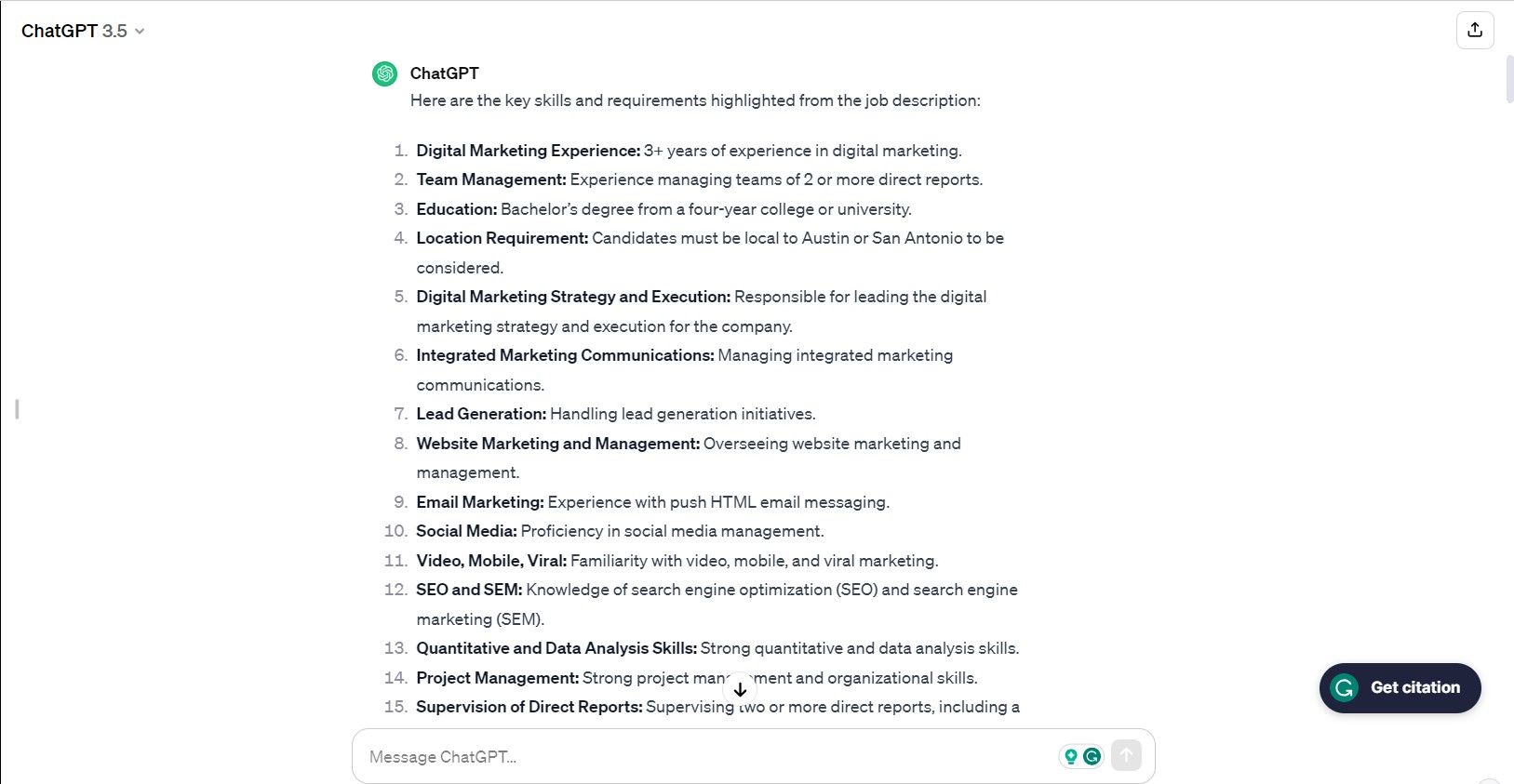
Next, I gave ChatGPT a hypothetical professional background for the next exercise. I laid out a few years of experience as a digital marketing manager at previous companies, key projects I led, big wins for clients, and all the usual résumé checklist items—just to set the table with a sample candidate profile. Armed with that, I told ChatGPT: “Based on my work history as a digital marketing manager below, do I meet the requirements for this position?” Putting it to the test to see how I’d stack up.
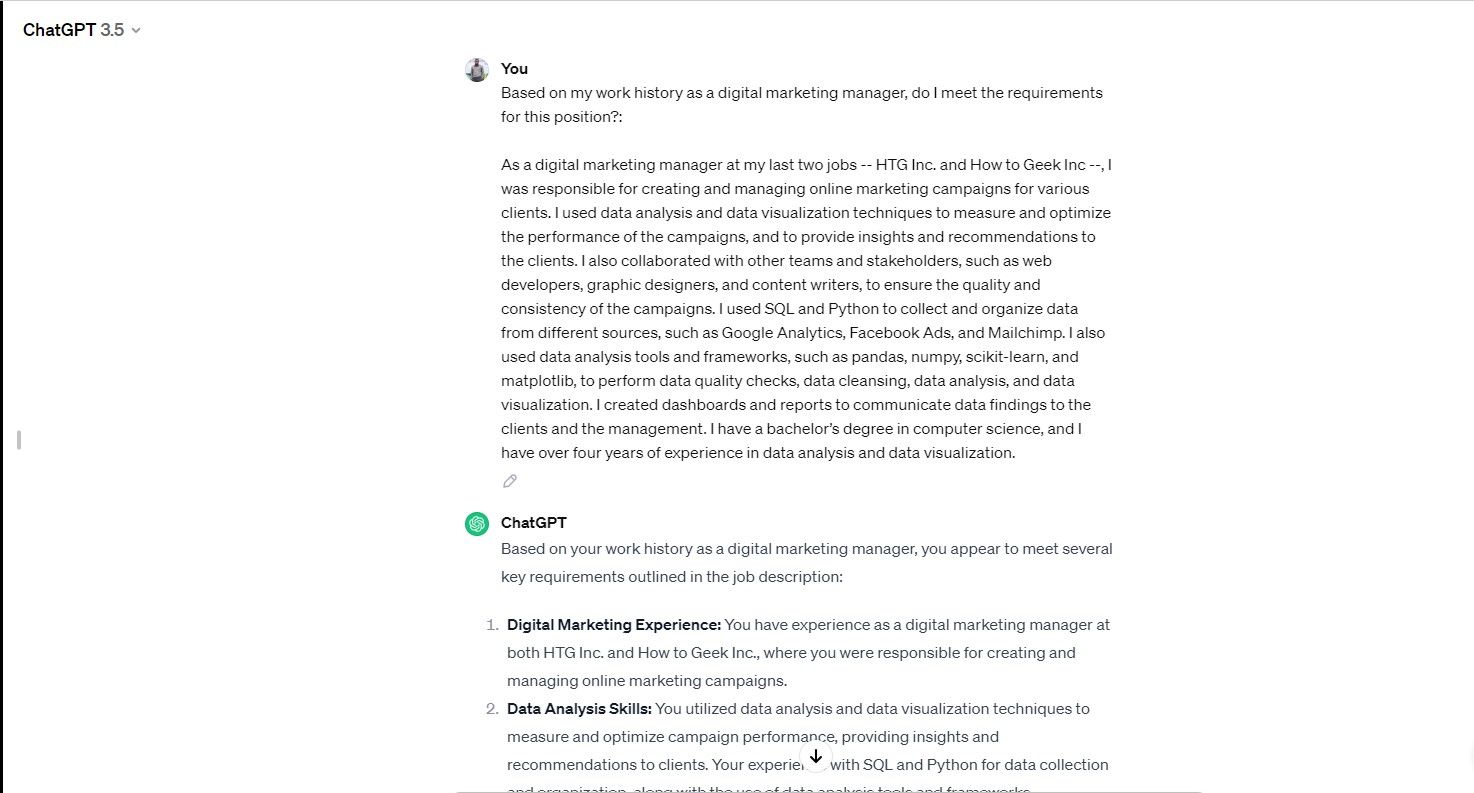
After crunching my background side-by-side with the job description details, it looks like I didn’t completely knock it out of the park. ChatGPT responded along the lines that my experience sounded pretty relevant but asked me to fill in a few gaps to get the full picture before it could make the call. It wanted more info on things like confirming if I directly managed a marketing team before, providing my current geographical location, and elaborating on my experience with remote collaboration tools and team communication.
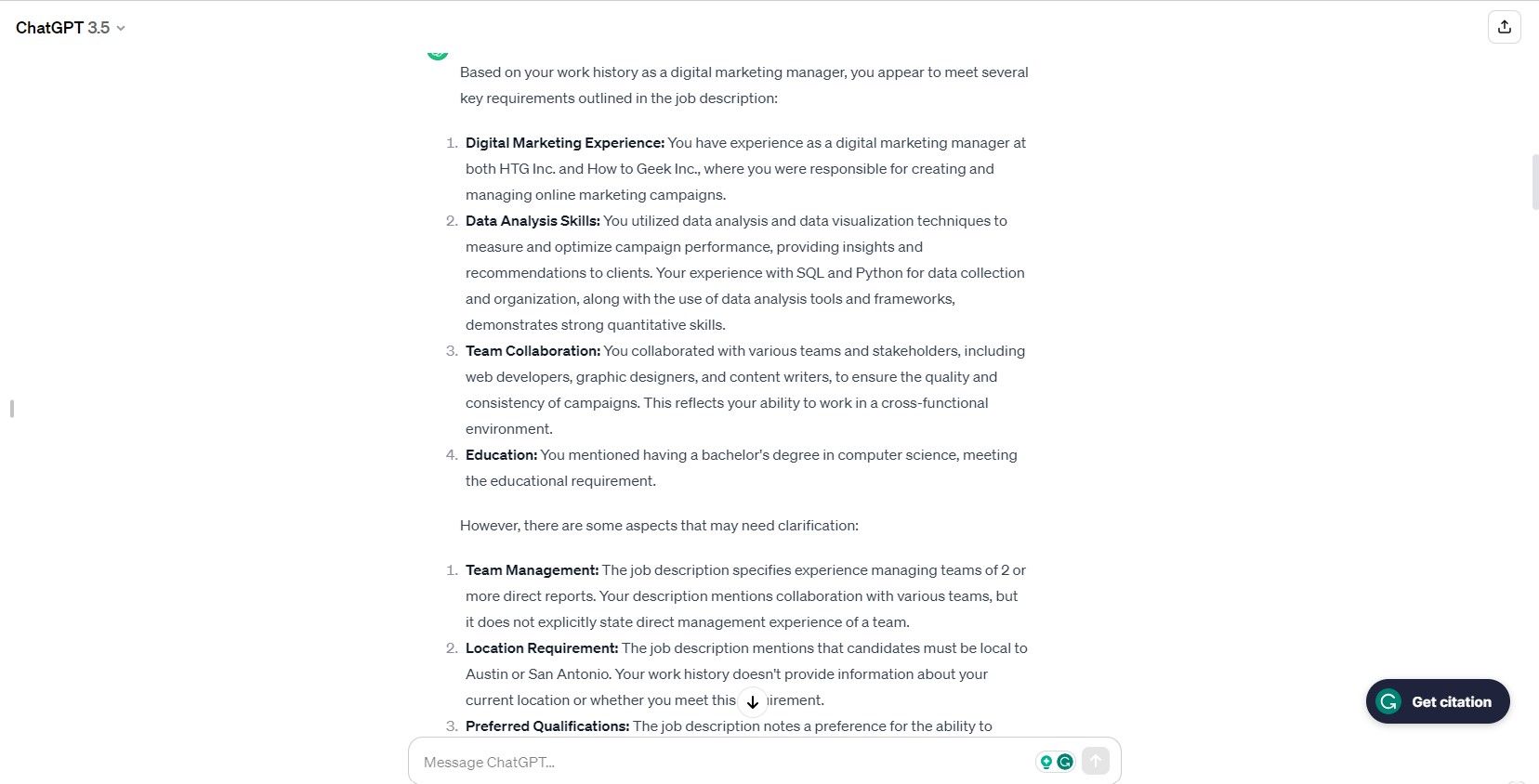
No problem! I quickly padded it with some made-up details about the senior team I supposedly managed and the collaboration tech I’m skilled in. For good measure, I threw in Austin as my location. ChatGPT came back, acknowledging I seem qualified enough now with that extra context.
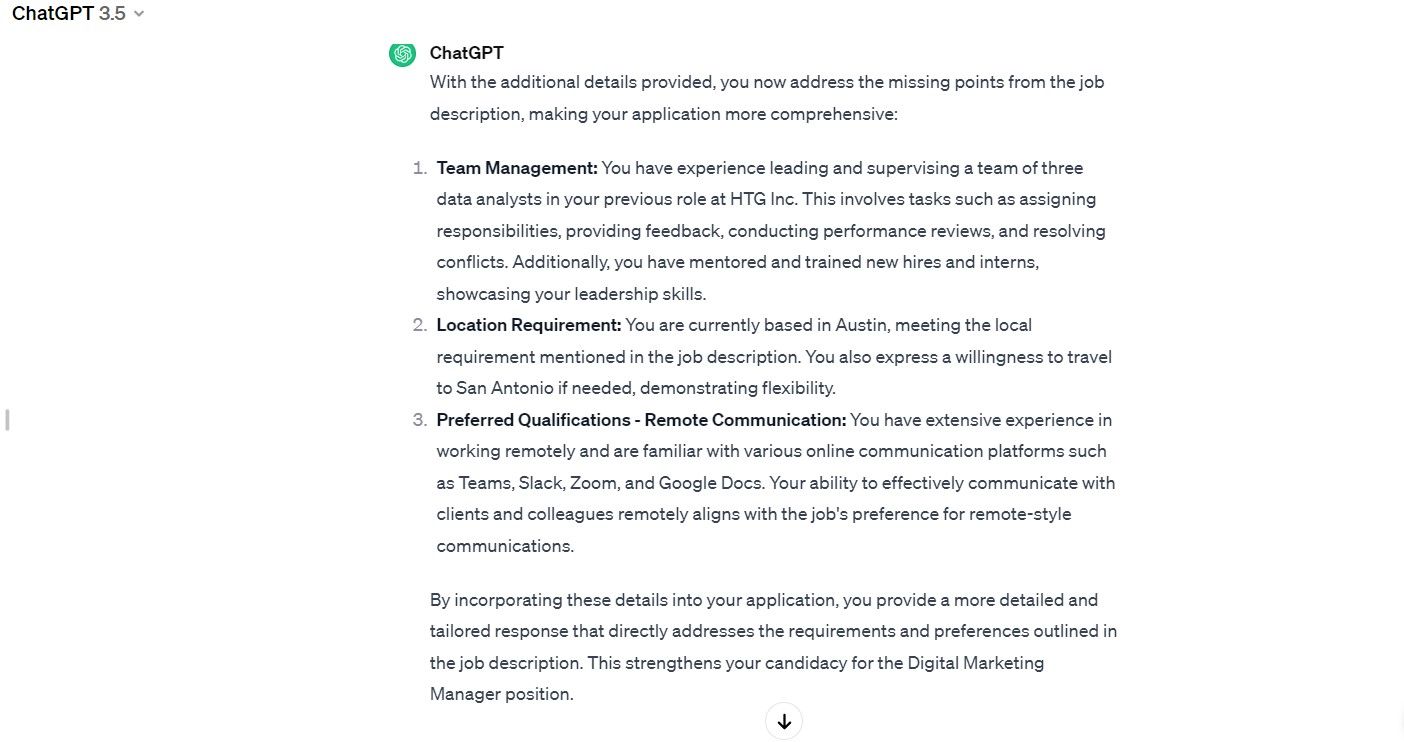
Create a Resume from Scratch with ChatGPT
Here’s the fun part. I let ChatGPT take a first pass at writing my resume. I prompted it to: “craft a resume that fits the job I’m applying for based on the information I provided before.” And it definitely took a first crack at it. ChatGPT put together a chronological resume, organizing my hypothetical background into nicely formatted sections: professional summary, work experience, education, skills, and additional information.
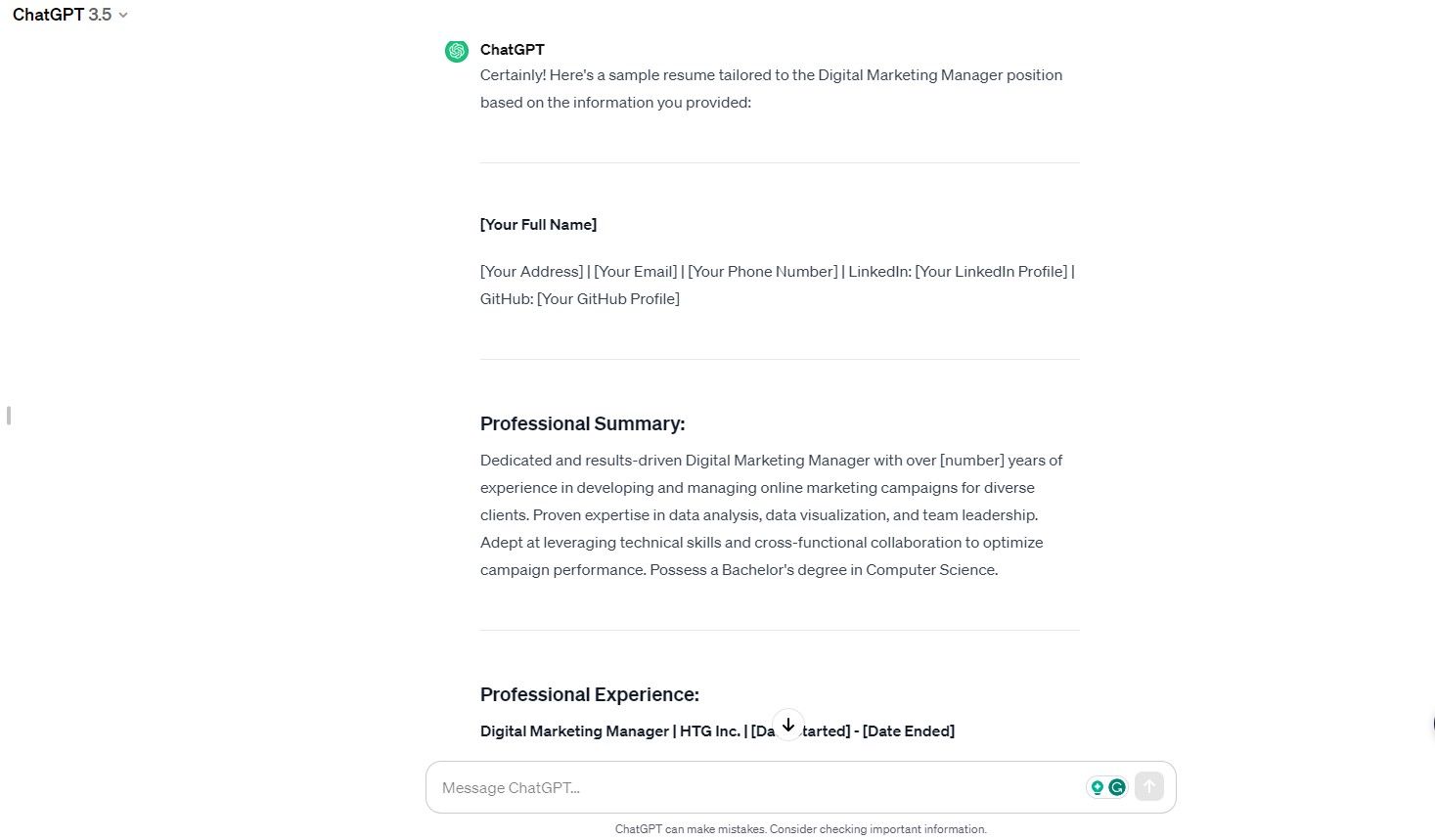
Obviously, to protect my personal information, I didn’t provide ChatGPT with any real specifics like my name, address, contact details, etc. The last thing you’d want is your data to get stored on some server to train algorithms without your permission! So, for privacy’s sake, it’s best to feed it career details only. Once you like the outcome, you can edit and polish ChatGPT’s draft, adding specifics like your personal details and tweaking anything that needs finesse (outside of ChatGPT, though). Use your human judgment to perfect the end result.
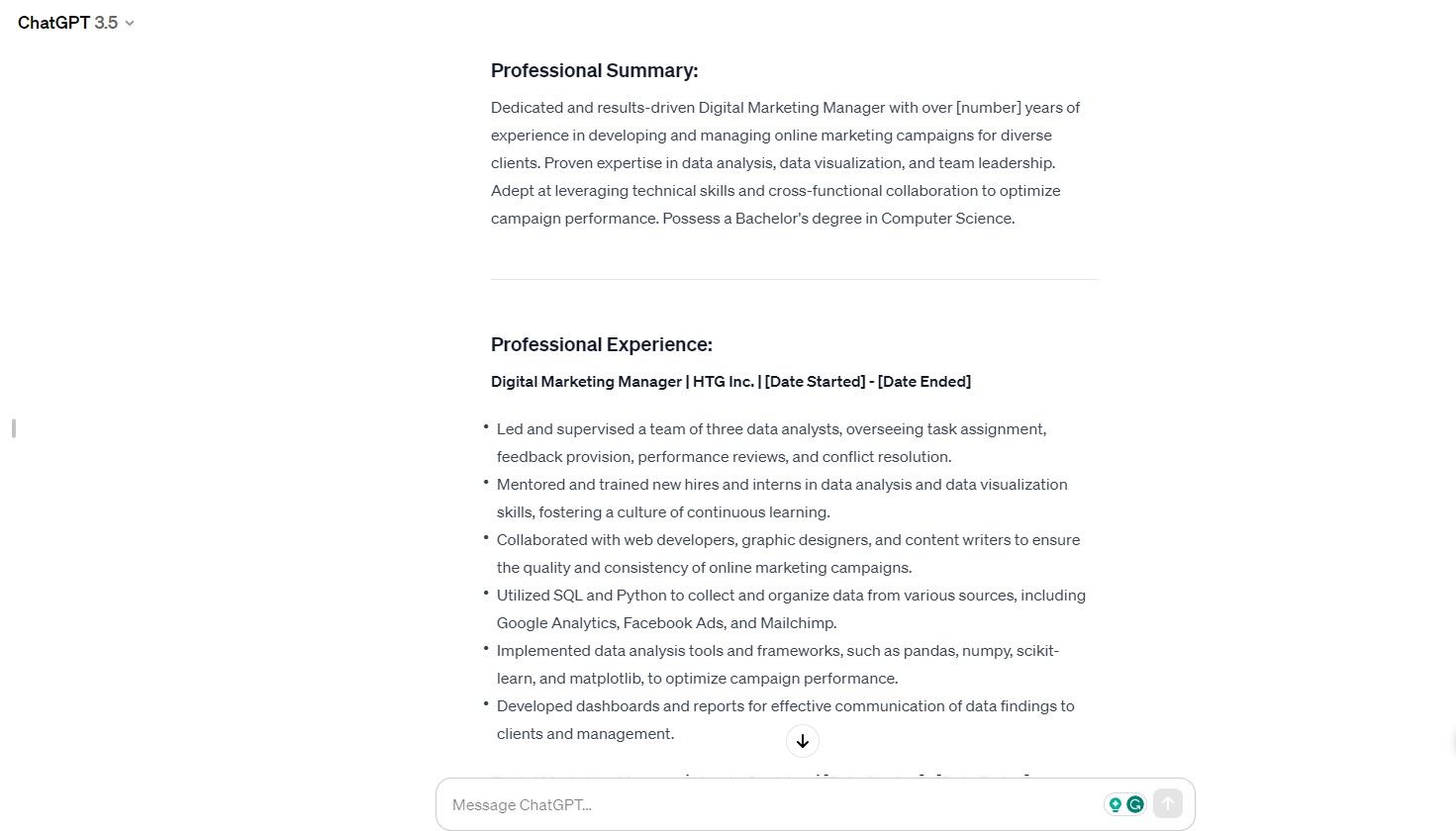
You Can Use ChatGPT to Strengthen Your Existing Resume
If you already have a resume you want to improve, you can use ChatGPT to help you polish and optimize it. Copy and paste your resume and the job description into ChatGPT. This will give it the information that it needs to work with. Then, tell ChatGPT to scan your resume and the job description and identify the key skills and requirements the employer seeks. You can prompt it with something like: “ChatGPT, here’s my resume: [Insert Resume] and here’s the job description [Insert Description]. Now, identify the most important qualifications, skills, and requirements the employer is seeking. Then give me some tips to tweak my resume to really highlight and optimize it for those key things they want.”
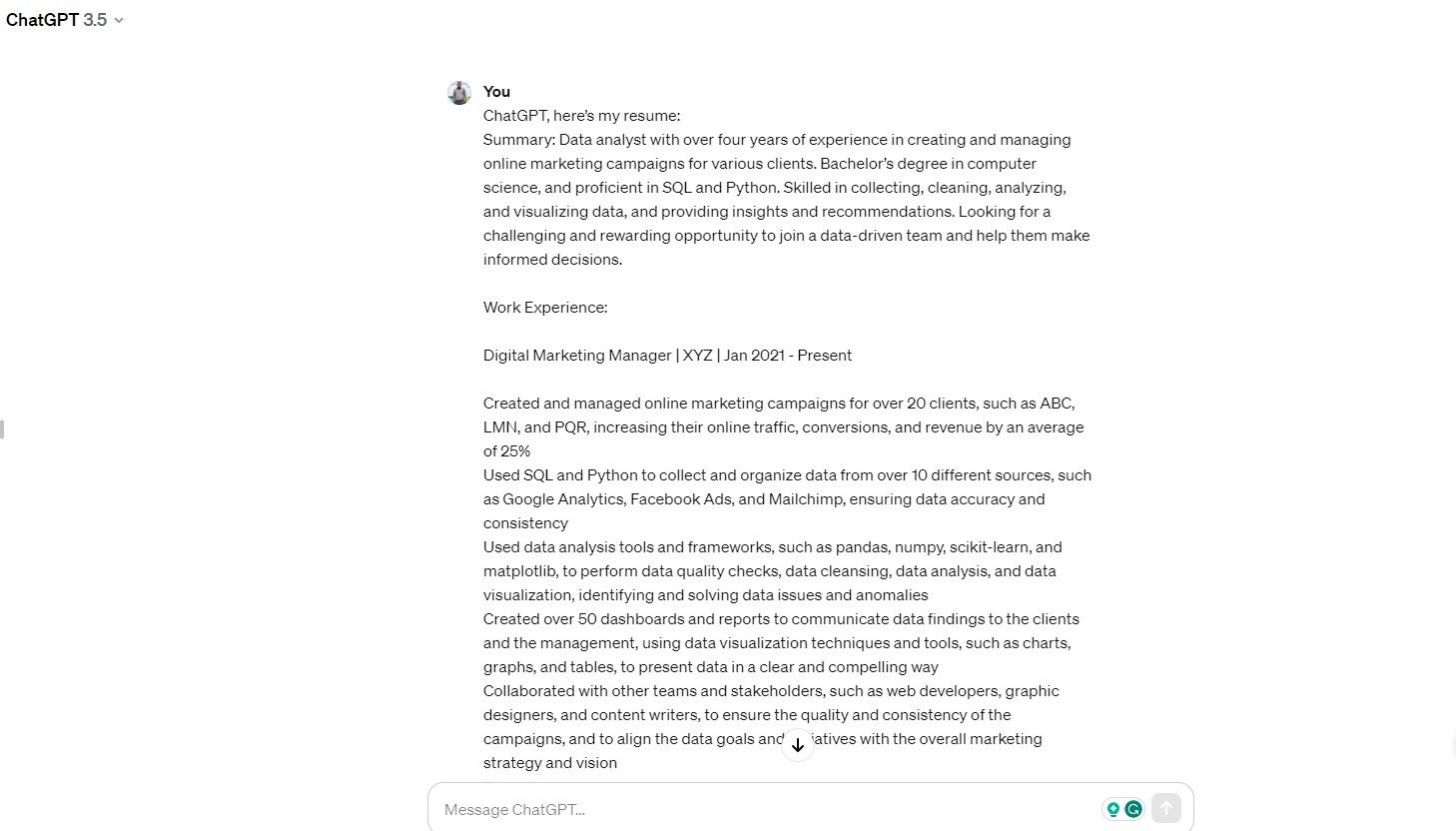
ChatGPT will dig into all that info and give you back some great pointers on little tweaks you can make, key stuff you should emphasize, or areas where you should elaborate on your experience. It can help you reshape things so your resume looks like the perfect, personalized fit for what they’ve asked for in a job listing.
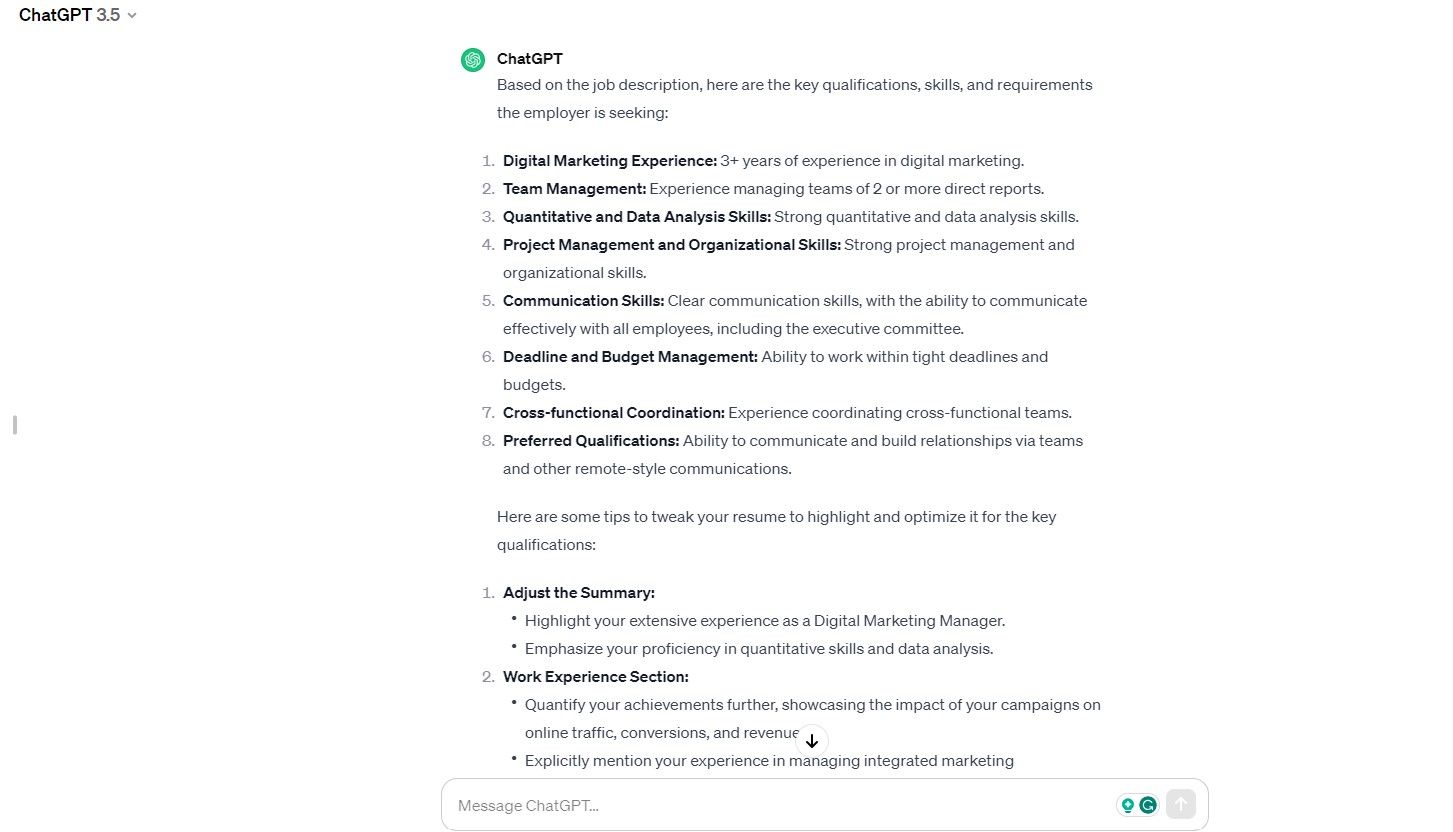
ChatGPT Can Optimize Your Resume to Be ATS-friendly
Applying for jobs at big corporations can feel like tossing a message in a bottle into the sea these days. Your precious resume often has to run through an Applicant Tracking System (ATS), which is basically an automated software bouncer that decides if you get to talk to a human recruiter or not. These ATS bots scan all incoming resumes, looking for specific skills, keywords, experience levels, etc., based on what the hiring manager is looking for. It’s how big companies deal with the tsunami of applications flowing in.
The problem is that many resumes never make it past ATS because they don’t have the exact key phrases the system’s programmed to find or aren’t formatted in a way it can easily scan. All that time crafting a personal, eye-catching resume for nothing.
Luckily, ChatGPT can jump in to help make sure your resume makes it through screening. Just copy/paste your resume text into ChatGPT and ask it to “review my resume to determine its compatibility with Applicant Tracking Systems (ATS).” It’ll ping back the key skills and experience you’ll want to emphasize in your resume and any industry lingo and job requirements to work into the text so all the bots recognize you as having what they are scanning for.
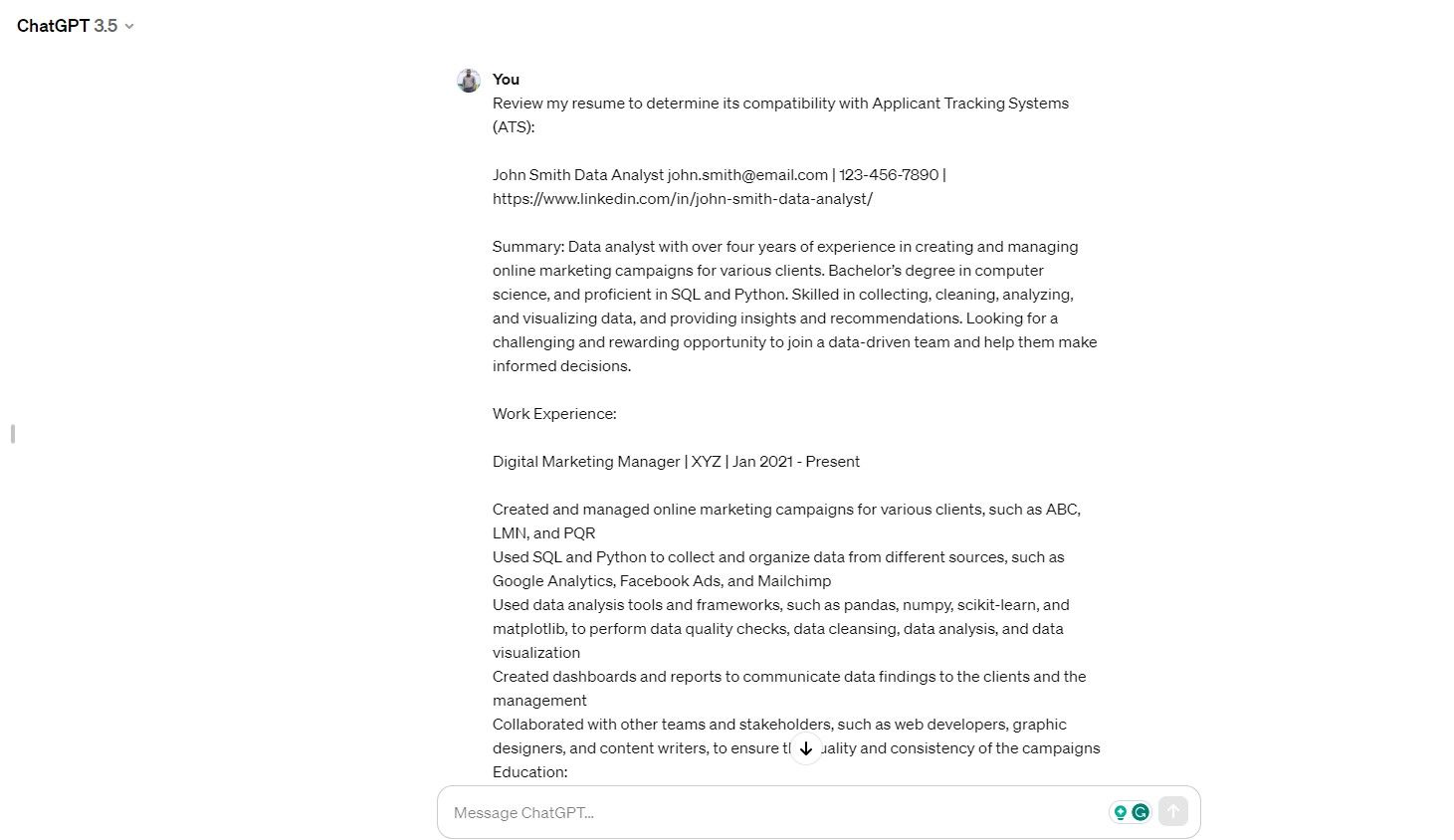
Make the changes ChatGPT suggests so everything the hiring manager cares about is clear and optimized for ATS friendliness. Do a once over yourself to polish the language and convey your awesome personality.
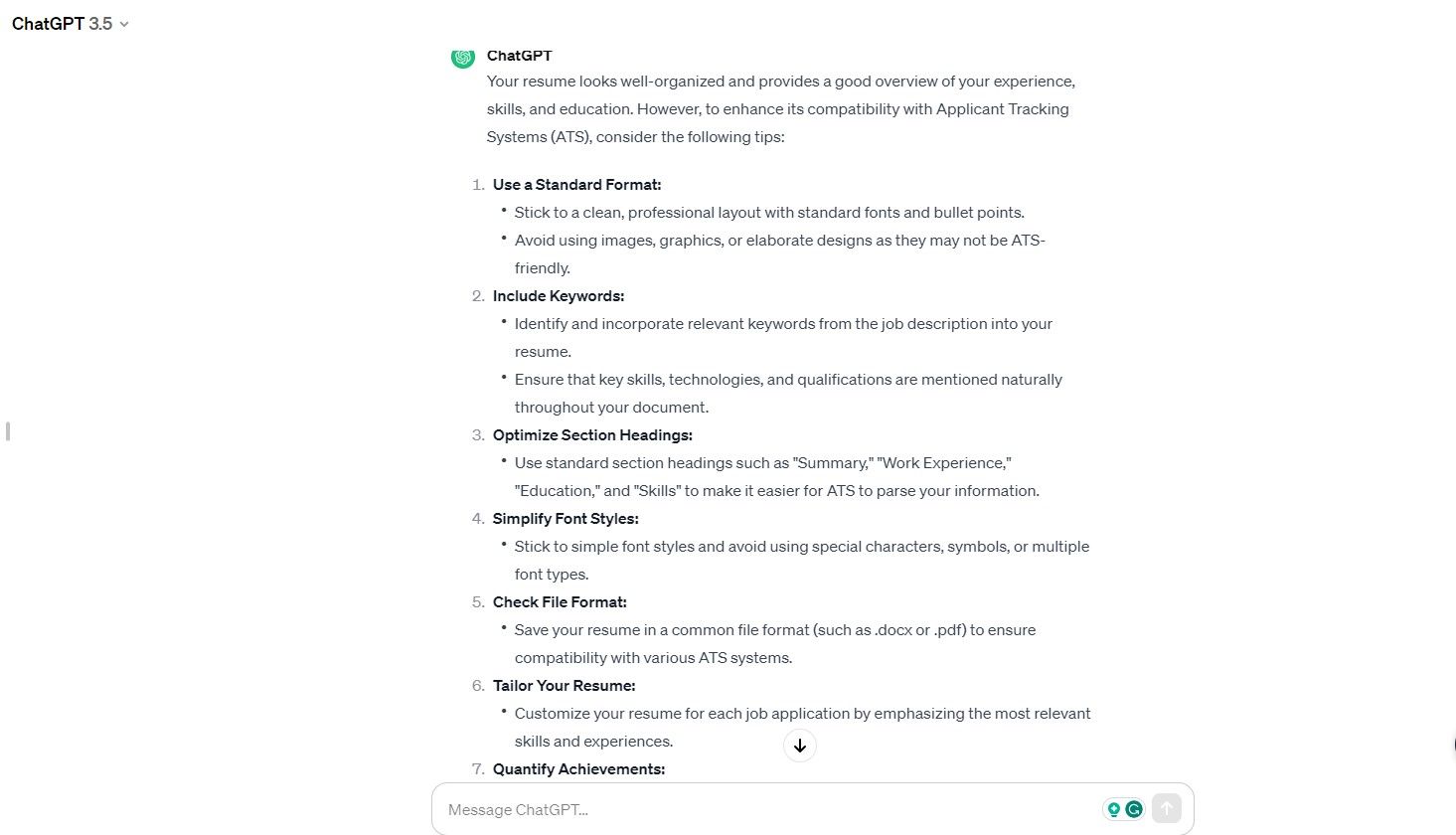
ChatGPT is more than just a resume builder. It’s also a friendly companion that can help you with various aspects of your job search, such as preparing for interviews, writing cover letters, negotiating salaries, and more. Just make sure to put your own human spin on any final output it gives you.
Also read:
- [New] 2024 Approved Transforming Social Media Nostalgia How to Edit Lookback
- [New] Elevating Your Drone Content Post-Production Fundamentals
- [New] In 2024, Technical Savvy Selecting the Best Capture Tools
- [New] In 2024, The Podcaster’s Guide to Seamless Streaming Setup
- Comprehensible Guide to Azure Voice to Text for 2024
- How to Factory Reset Itel P40 If I Forgot Security Code or Password? | Dr.fone
- How to Perform Hard Reset on Huawei P60? | Dr.fone
- How to Perform Hard Reset on Realme 11 Pro+? | Dr.fone
- How To Repair Apple iPhone XR System Issues? | Dr.fone
- How To Transfer Data From Apple iPhone 15 Pro To Other iPhone 14 Pro devices? | Dr.fone
- iCloud Separation How To Disconnect Apple iPhone 15 Pro and iPad
- In 2024, Apex of HD Technology Leading Recorder Brands Decoded
- In 2024, Top Profit Generating Online Entertainer
- Mastering Visual Depth with HDRI Techniques Over SDR for 2024
- Repair Video Tool - Repair all your damaged video files of Vivo V30 Lite 5G on Mac
- Simple ways to get lost music back from Google Pixel 8 Pro
- Things You Dont Know About Vivo T2 Pro 5G Reset Code | Dr.fone
- What You Need To Know To Improve Your OnePlus Nord CE 3 5G Hard Reset | Dr.fone
- Which is the Best Fake GPS Joystick App On Vivo V29 Pro? | Dr.fone
- Title: Effective Strategies for Using ChatGPT to Generate Professional Resumes Tailored for Various Positions
- Author: Ian
- Created at : 2025-02-13 16:45:48
- Updated at : 2025-02-19 23:13:08
- Link: https://techidaily.com/effective-strategies-for-using-chatgpt-to-generate-professional-resumes-tailored-for-various-positions/
- License: This work is licensed under CC BY-NC-SA 4.0.